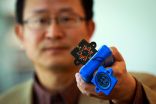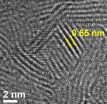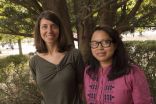(Press-News.org) Researchers at the University of Cambridge have managed to reconstruct the early stage of mammalian development using embryonic stem cells, showing that a critical mass of cells – not too few, but not too many – is needed for the cells to being self-organising into the correct structure for an embryo to form.
All organisms develop from embryos: a cell divides generating many cells. In the early stages of this process, all cells look alike and tend to aggregate into a featureless structure, more often than not a ball. Then, the cells begin to 'specialise' into different types of cell and space out asymmetrically, forming an axis which begins to provide a structure for the embryo to develop along.
In animal embryos this stage is followed by a process known as gastrulation: a choreographed movement of the cells that, using the initial axis as a reference, positions the head and the tail, the front and the back. During the process, the cells begin to forum three distinct layers: the endoderm, mesoderm and ectoderm, determining which tissues or organs the cells will then develop into.
Professor Alfonso Martinez-Arias from the Department of Genetics at the University of Cambridge, who led the research, says: "Gastrulation was described by biologist Professor Lewis Wolpert as being 'truly the most important event in your life' because it creates the blueprint of an organism. Axis formation and gastrulation are the two central processes that initiate the development of an organism and are inextricably associated with the embryo. We have managed to recreate this for the first time in the lab."
Professor Martinez-Arias and colleagues, supported by the European Research Council and the Wellcome Trust, have reconstructed these early stages of development using mouse embryonic stem cells. Embryonic stem cells, discovered in the Department of Genetics in the 1980s (for which Sir Martin Evans was awarded the Nobel Prize in Physiology or Medicine 2007), have become an important tool for developmental biology, understanding disease, and in regenerative medicine due to the ability to give rise to all cell types in culture. Over the last few years, they have been used to 'grow' organs including the eye and the cerebral cortex; surprisingly, these structures develop without an axis.
In research published today in the journal Development, the researchers report a way to coax cells to reorganize in the manner that they do in an embryo, creating an axis and undergoing movements and organisations that mimic the process of gastrulation. Over the years researchers have been making aggregates of embryonic stem cells to obtain certain cell types, for example red blood cells. However, these aggregates lack structure and the different cell types emerge in a disorganised fashion. This is the first time that researchers have been able to elicit axis formation, spatial organisation and gastrulation-like movements from aggregates of embryonic stem cells.
The researchers show that if the number of cells aggregated initially is similar to that of a mouse embryo, the cells generate a single axis and this serves as a template for a sequence of events that mimics those of the early embryo. By manipulating the signals that the cells see at a particular time, the researchers were able to influence what type of cell they become and how they are organised. In one of the experiments, for example, activation of a particular signal at the correct time elicits the appearance of the mesoderm, endoderm and ectoderm – the precursors of all cell types – with a spatial organization similar to that of an embryo.
Using this experimental system, the researchers were able to generate the early stages of a spinal cord, which they showed forms as part of the process of gastrulation. This finding complements previous research from the University of Edinburgh and the National Institute for Medical Research which showed that embryonic stem cells can be coaxed into this spinal cord cells; however, the Cambridge researchers showed that the in the embryo-like aggregates, the structural organization is more robust and allows for the polarised growth of the tissue.
Professor Martinez-Arias adds: "It is early days but this system promises insights into the early stages of development and what determines the specification of the different cell types. This will allow more robust protocols for differentiation with cues that mimic those that the cells are subject to in embryos.
"Most significantly, the system will provide a means to test, experimentally, how a homogeneous group of cells organizes itself in space, a central process in the development of any organism, and the ability to recreate in culture the niches that adult stem cells create during embryogenesis and which have remained elusive experimentally."
INFORMATION:
Los Angeles, CA (November 4, 2014) How does an individual's happiness level reflect societal conditions? A new article out today in the first issue of Policy Insights from the Behavioral and Brain Sciences (PIBBS) finds that similar to how GDP measures the effectiveness of economic policies, happiness can and should be used to evaluate the effectiveness of social policies.
Authors Shigehiro Oishi and Ed Diener examined research evaluating the effectiveness of policy related to unemployment rate, tax rate, child care, and environmental issues to determine if it's possible ...
Los Angeles, CA (November 4, 2014) The growing disparity in economic inequality has become so stark that even Janet Yellen, Federal Reserve chairwoman, recently expressed concern. Interestingly, new research has discovered that American citizens desire an unequal, but more equal distribution of wealth and income. Lower levels of this "unequality" are associated with decreased unethical behavior and increased motivation and labor productivity. This study is published today in the inaugural issue of Policy Insights from the Behavioral and Brain Sciences (PIBBS).
"People ...
Los Angeles, CA (November 4, 2014) With so much attention to curriculum and teaching skills to improve student achievement, it may come as a surprise that something as simple as how a classroom looks could actually make a difference in how students learn. A new analysis finds that the design and aesthetics of school buildings and classrooms has surprising power to impact student learning and success. The paper is published today in the inaugural issue of Policy Insights from the Behavioral and Brain Sciences (PIBBS).
Surveying the latest scientific research, Sapna Cheryan, ...
SALT LAKE CITY, Nov. 4, 2014 – University of Utah engineers have developed a new type of carbon nanotube material for handheld sensors that will be quicker and better at sniffing out explosives, deadly gases and illegal drugs.
A carbon nanotube is a cylindrical material that is a hexagonal or six-sided array of carbon atoms rolled up into a tube. Carbon nanotubes are known for their strength and high electrical conductivity and are used in products from baseball bats and other sports equipment to lithium-ion batteries and touchscreen computer displays.
Vaporsens, ...
PROVIDENCE, R.I. [Brown University] — We celebrate our triumphs over adversity, but let's face it: We'd rather not experience difficulty at all. A new study ties that behavioral inclination to learning: When researchers added a bit of conflict to make a learning task more difficult, that additional conflict biased learning by reducing the influence of reward and increasing the influence of aversion to punishment.
This newly found relationship between conflict and reinforcement learning suggests that the circuits in the frontal cortex that calculate the degree of ...
HOUSTON – (Nov. 4, 2014) – Rice University scientists who want to gain an edge in energy production and storage report they have found it in molybdenum disulfide.
The Rice lab of chemist James Tour has turned molybdenum disulfide's two-dimensional form into a nanoporous film that can catalyze the production of hydrogen or be used for energy storage.
The versatile chemical compound classified as a dichalcogenide is inert along its flat sides, but previous studies determined the material's edges are highly efficient catalysts for hydrogen evolution reaction ...
HOUSTON – (Nov. 4, 2014) – A majority of Madagascar's 101 species of lemurs are threatened with extinction, and that could have serious consequences for the rainforests they call home. A new study by Rice University researchers shows the positive impacts lemurs can have on rainforest tree populations, which raises concerns about the potential impact their disappearance could have on the region's rich biodiversity.
A large proportion of trees in Madagascar's rainforest have fruits eaten by lemurs. Lemurs in turn disperse the seeds of their fruit trees throughout ...
OAK BROOK, Ill. – Researchers using coronary computed tomography angiography (CCTA) have found a close association between high-risk coronary artery plaque and a common liver disease. The study, published online in the journal Radiology, found that a single CT exam can detect both conditions.
Previous research has shown that CCTA can detect high-risk coronary artery plaque, or plaque prone to life-threatening ruptures. For the new study, researchers looked at associations between high-risk plaque and non-alcoholic fatty liver disease (NAFLD), a condition characterized ...
Over eighty percent of breast cancer patients in the United States use complementary therapies following a breast cancer diagnosis, but there has been little science-based guidance to inform clinicians and patients about their safety and effectiveness. In newly published guidelines from the Society for Integrative Oncology, researchers at Columbia University's Mailman School of Public Health and the Herbert Irving Comprehensive Cancer Center with colleagues at MD Anderson Cancer Center, University of Michigan, Memorial Sloan Kettering, and other institutions in the U.S. ...
PHILADELPHIA - Two new studies from the Abramson Cancer Center and the Perelman School of Medicine at the University of Pennsylvania offer hope for breast cancer survivors struggling with cancer-related pain and swelling, and point to ways to enhance muscular strength and body image. The studies appear in a first of its kind monograph from the Journal of the National Cancer Institute Monographs focusing on integrative oncology, which combines a variety of therapies, some non-traditional, for maximum benefit to cancer patients.
In the first study, A Hybrid Effectiveness-Implementation ...


